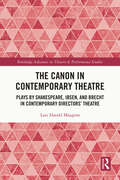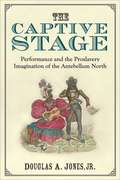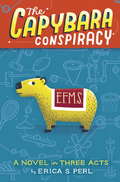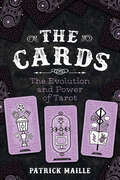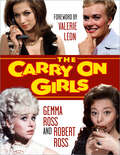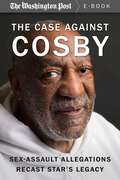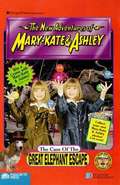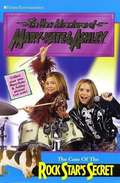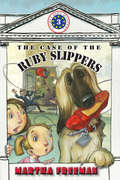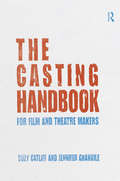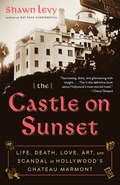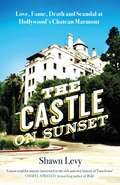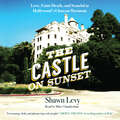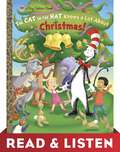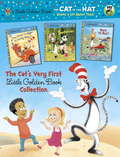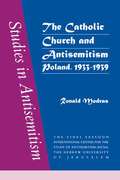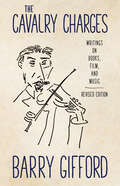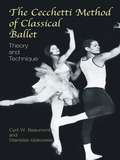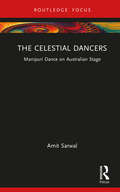- Table View
- List View
The Canadian Kings of Repertoire: The Story of the Marks Brothers
by Michael V. TaylorThe Marks Brothers may well have been the most remarkable theatrical family in Canadian history. A phenomenon on the vaudeville circuit, the seven brothers left the farm and took to the boards and the footlights throughout the latter part of the 19th century and into the 1920s. The brothers from Christie Lake, near Perth in Eastern Ontario, played to an estimated eight million Canadians, as well as to sizeable audiences in the United States. Their road shows, largely melodramas and comedy, kept audiences crying, booing, laughing and cheering until movies sounded the death knell for touring repertory companies. The publication of The Canadian Kings of Repertoire brings back for one more curtain call the seven Marks boys, top hats, diamond rings and all. Joining them in a farewell performance are their glamorous leading ladies and a superb cast of supporting players. So clear the aisles and up with the curtain. It’s showtime once more.
The Canon in Contemporary Theatre: Plays by Shakespeare, Ibsen, and Brecht in Contemporary Directors’ Theatre (ISSN)
by Lars Harald MaagerøThis book explores the relationship between contemporary theatre, particularly contemporary theatre directors, and the dramatic canon of plays.Through focusing on productions of plays by three canonical playwrights (Shakespeare, Ibsen, and Brecht) by eight contemporary European directors (Michael Buffong, Joe Hill-Gibbins, and Emma Rice from the UK, Christopher Rüping from Germany, Thorleifur Örn Arnarsson from Iceland, and Kjeriski Hom, Alexander Mørk-Eidem, and Sigrid Strøm Reibo from Norway) the book investigates why and how the theatre continues to engage with canonical plays. In particular, the book questions the political and cultural implications of theatrical reproductions of the literary canon. Drawing on Chantal Mouffe’s theories of agonism and ‘critical art,’ the book investigates whether theatrical reproduction of the canon always reconstitutes the hegemonic values and ideologies of the canon, or whether theatrical interventions in the canon can challenge such values and ideologies, and thereby also challenge the dominant ideologies and hegemonies of contemporary culture and society.This study will be of great interest to academics and students in drama and theatre, particularly those who work with theatre in the twenty-first century, directors’ theatre, and the political impact of theatre.
The Canterbury Puzzles
by Henry DudeneyFor the mastermind who has what it takes to solve the tricky conundrums from Britain's first and greatest puzzle master.---------------------------------------Solve the puzzle of The Mystery of Ravensdene Park . . . trace the route of the butler, the gamekeeper and the two anonymous guests and the key to the mystery will reveal itself.---------------------------------------Decipher the riddle of The Frogs' Ring for The Merry Monks of Riddlewell . . . ---------------------------------------At The Squire's Christmas Puzzle Party ascertain just how many kisses had been given Under the Mistletoe Bough . . . ---------------------------------------First published in 1907, Dudeney's The Canterbury Puzzles is a classic of the genre, based on characters from Chaucer's Tales. The book contains 114 puzzles suitable for young enthusiasts, recreational mathematicians and veteran puzzlers alike. As challenging today as it was over a century ago, this ingenious book will provide hours-worth of puzzles to keep your brain alert."Regular exercise is supposed to be as necessary for the brain as for the body. Many of us are very apt to suffer from mental cobwebs, and there is nothing equal to the solving of puzzles for sweeping them away." - Henry Dudeney (1847-1930)
The Captive Stage: Performance And The Proslavery Imagination Of The Antebellum North
by Douglas A. JonesIn The Captive Stage, Douglas A. Jones, Jr. argues that proslavery ideology remained the dominant mode of racial thought in the antebellum north, even though chattel slavery had virtually disappeared from the region by the turn of the nineteenth century--and that northerners cultivated their proslavery imagination most forcefully in their performance practices. Jones explores how multiple constituencies, ranging from early national artisans and Jacksonian wage laborers to patrician elites and bourgeois social reformers, used the stage to appropriate and refashion defenses of black bondage as means to affirm their varying and often conflicting economic, political, and social objectives. Joining performance studies with literary criticism and cultural theory, he uncovers the proslavery conceptions animating a wide array of performance texts and practices, such as the "Bobalition" series of broadsides, blackface minstrelsy, stagings of the American Revolution, reform melodrama, and abolitionist discourse. Taken together, he suggests, these works did not amount to a call for the re-enslavement of African Americans but, rather, justifications for everyday and state-sanctioned racial inequities in their post-slavery society. Throughout, The Captive Stage elucidates how the proslavery imagination of the free north emerged in direct opposition to the inclusionary claims black publics enacted in their own performance cultures. In doing so, the book offers fresh contexts and readings of several forms of black cultural production, including early black nationalist parades, slave dance, the historiography of the revolutionary era, the oratory of radical abolitionists and the black convention movement, and the autobiographical and dramatic work of ex-slave William Wells Brown.
The Capybara Conspiracy: A Novel in Three Acts
by Erica S. PerlFans of Tim Federle and Louis Sachar will love this hilarious story of what happens when the non-jocks kidnap their sports-obsessed school's beloved mascot. Seventh-grade playwright Olive Henry is frustrated by her middle school's lack of appreciation for anything but sports. While the principal drones on and on during morning announcements about the sports teams' victories, all non-athletic club meetings are relegated to the school basement, never to be mentioned on the loudspeaker. So Olive and her best friend, Reynaldo, hatch a plan to kidnap the school's capybara mascot, planning to return it, heroically, just in time for the school's pep rally and claim a reward: permission for their drama club to practice in the auditorium. And, hopefully, some overdue respect for the school's non-athletes. But when an animal-rights student activist and an undercover athlete with murky motivations join in the conspiracy, their plans--along with Cappy the capybara--veer wildly out of Olive's control.
The Cards: The Evolution and Power of Tarot
by Patrick MailleTarot cards have been around since the Renaissance and have become increasingly popular in recent years, often due to their prevalence in popular culture. While Tarot means many different things to many different people, the cards somehow strike universal chords that can resonate through popular culture in the contexts of art, television, movies, even comic books. The symbolism within the cards, and the cards as symbols themselves, make Tarot an excellent device for the media of popular culture in numerous ways. They make horror movies scarier. They make paintings more provocative. They provide illustrative structure to comics and can establish the traits of television characters. The Cards: The Evolution and Power of Tarot begins with an extensive review of the history of Tarot from its roots as a game to its supposed connection to ancient Egyptian magic, through its place in secret societies, and to its current use in meditation and psychology. This section ends with an examination of the people who make up today’s tarot community. Then, specific areas of popular culture—art, television, movies, and comics—are each given a chapter in which to survey the use of Tarot. In this section, author Patrick Maille analyzes such works as Deadpool, Books of Magic by Neil Gaiman, Disney's Haunted Mansion, Sherlock Holmes: Game of Shadows, The Andy Griffith Show, Buffy the Vampire Slayer, and King of the Hill. The cards are evocative images in their own right, but the mystical fascination they inspire makes them a fantastic tool to be used in our favorite shows and stories.
The Carnival of the Animals
by Jack PrelutskyA great way to introduce children to classical music.America&’s first Children's Poet Laureate has written all-new verses to accompany the composer Camille Saint-Saëns&’s The Carnival of the Animals, and the illustrator of the Harry Potter books has turned these rollicking rhymes into a picture-book fun fest. A note to parents and teachers by Judith Bachleitner, head of the music department at the prestigious Rudolf Steiner School in New York City, suggests ways preschoolers can act out the music—tromp like an elephant, hop like a kangaroo, glide like a swan—or, for older children, be creatively inspired by this joyful work.
The Carole: A Study Of A Medieval Dance
by Robert MullallyThe carole was the principal social dance in France and England from c. 1100 to c. 1400 and was frequently mentioned in French and English medieval literature. However, it has been widely misunderstood by contributors in recent citations in dictionaries and reference books, both linguistic and musical. The carole was performed by all classes of society - kings and nobles, shepherds and servant girls. It is described as taking place both indoors and outdoors. Its central position in the life of the people is underlined by references not only in what we might call fictional texts, but also in historical (or quasi-historical) writings, in moral treatises and even in a work on astronomy. Dr Robert Mullally's focus is very much on details relevant to the history, choreography and performance of the dance as revealed in the primary sources. This methodology involves attempting to isolate the term carole from other dance terms not only in French, but also in other languages. Mullally's groundbreaking study establishes all the characteristics of this dance: etymological, choreographical, lyrical, musical and iconographical.
The Carrot Caper (Baby Looney Tunes)
by Lee HowardWho is raiding Granny's garden? Baby Bugs, Baby Daffy, Baby Tweety and Baby Sylvester set out to find who is stealing the vegetables from Granny's garden. Limited picture descriptions present.
The Carry On Girls
by Robert Ross Gemma RossFar more than mere eye candy, these in-control, hard-working, and pioneering ladies were an early and earnest manifestation of Girl Power in the British film industry. This book will provide an invaluable celebration of the highly talented and forever decorative screen sirens that bewitched Carry On heroes Sid James, Kenneth Connor, Leslie Phillips, Bernard Bresslaw, Jim Dale, Peter Butterworth and, yes, even, Kenneth Williams.Through never-before-seen publicity material, exclusive interviews with the girls themselves and affectionate biographies by Carry On historian Robert Ross, this will be the most thumbed coffee table book ever to hit your coffee table!Soap opera favourites Amanda Barrie (Alma in Coronation Street) and Wendy Richard (Pauline Fowler in EastEnders), Bond girls Margaret Nolan, Madeline Smith and the Goldfinger star herself, Shirley Eaton, as well as international glamour stars Elke Sommer and Dany Robin, will be featured in candid interviews and stunning portrait shots.This book will be a long overdue salute to dozens of beloved Carry On actresses, from the courageous Liz Fraser to the ill-fated Imogen Hassall, and from the national treasure Barbara Windsor to the unfairly forgotten Sally Douglas. Each with a poignant and personal memory from fellow Carry On legend Valerie Leon, who will provide her unique and exclusive commentary.The book will also investigate the continuing cult of the Carry On girl, from Daniella Westbrook’s Carry On London photographic sessions to Page 3 girl Malene Espensen paying tribute to the Carry On Camping bra-burst of Barbara Windsor. All done in the best possible taste, of course, with the affection and joy that still makes the Carry On films the eternal toast of ITV3 and BritBox.The book will feature a wealth of illustrations ranging from cheesecake shots for Tit-Bits to relaxed behind-the-scenes poses with Carry On filmmakers Peter Rogers and Gerald Thomas and comedy legends such as Phil Silvers, Harry H. Corbett, Bob Monkhouse and Bernard Cribbins.Full of intimate tales from the soundstages of Pinewood Studios, snapshots of a lost industry and oodles of laughs, this is the ultimate tribute to a fun-filled era when British crumpet was at its spiciest!
The Case Against Cosby: Sex-Assault Allegations Recast Star's Legacy
by The Washington PostMore than thirty women have alleged sexual misconduct against Bill Cosby, ranging from groping to rape. With so many speaking against him, The Washington Post asks: What is the case against Cosby? Bill Cosby has always played the good guy on stage and TV, building his career on his easygoing, family-friendly comic persona. So the overwhelming tide of sexual assault allegations against him is hard for many Americans to reconcile with the character they know from the airwaves. The accusations represent a stunning reshaping of his lifelong legacy in an extraordinarily short amount of time. Yet Cosby has yet to be charged with any crime. Cosby's attorney has called the accusations against the comedian "ridiculous." His wife has defended him wholeheartedly, and Cosby himself has dismissed the charges as rumor and innuendo. The Washington Post has interviewed five of the women who accused Cosby of assaulting them. The women agreed to speak on the record and to have their identities revealed. The Post also has reviewed court records that shed light on the allegations of a former director of women's basketball operations at Temple University and the thirteen "Jane Doe" accusers who stood with her.
The Case Of The Great Elephant Escape
by June DoolittleWhere in the world could someone hide an elephant? That's what Ashley and I had to find out. The circus was in town, and their newest star -- Maysie, the baby elephant-was missing! It was our biggest mystery yet! We had to find Maysie before show time -- which was only two hours away! No problem. It shouldn't be too hard to find something that weighs a ton, right? Wrong!
The Case Of The Rock Star's Secret (The New Adventures of Mary-Kate and Ashley)
by Melinda Metz Mary-Kate Olsen Ashley OlsenCrank it up! Ashley and I were in a rock band! We were practicing for our first concert--and we were jammin'! We couldn't wait to blow the crowd away! But then weird stuff started happening. Someone replaced our singer's shampoo with black hair dye. A huge explosion went off outside our dress rehearsal. And all our instruments disappeared--right before the concert! Who was trying to stop the music? We had to find out--fast!
The Case of the Ruby Slippers (First Kids Mystery #3)
by Martha FreemanAunt Jen, the official White House hostess, is being thrown a surprise party with a Wizard of Oz theme. A dog that looks just like Toto will be there -- and so will the famous ruby slippers that Judy Garland wore in the movie. But when the box arrives from the Smithsonian Museum, the slippers aren't in it! Never fear, First Kids Cammie and Tessa are on the case. White House dog Hooligan finds one slipper, but no one know where or how. A surprising revelation reveals the thief's identity. Filled with humor and White House inside information, this third First Kids Mystery is exciting from start to finish.
The Casting Handbook: For Film and Theatre Makers
by Suzy Catliff Jennifer GranvilleCasting is a crucial creative element of any production - and yet the craft and skills needed to put together a successful and exciting cast are often overlooked. The Casting Handbook explains the casting process from beginning to end and covers everything producers and directors needs to know – as well as proving a fascinating and illuminating read for actors. The book explores: how to prepare a breakdown where to source actors how to prepare for a casting session how to make casting decisions how a cast is put together how deals are done ethics and the law, with special reference to casting children how a casting director contributes to the initial development of the script how the casting works from fringe theatre to Hollywood blockbusters The Casting Handbook considers actors’, producers’, agents’ and directors’ relationship with a casting director, the day to day work that is casting, and how approaching it in a professional and informed manner can make the difference to the final product. Including interviews with actors, agents, directors, casting directors and producers; case studies; exercises; and a fact file of useful templates and contacts, this book offers a thorough induction into the casting process, suitable for students and early career professionals in any media.
The Castle on Sunset: Life, Death, Love, Art, and Scandal at Hollywood's Chateau Marmont
by Shawn LevyThe definitive—and salacious—history of the iconic hotel that Hollywood stars have called a home away from home for almost a century.&“Fascinating, dishy, and glimmering with insight.... This is the definitive book about Hollywood&’s most storied hotel.&” —Cheryl Strayed, bestselling author of WildSince 1929, Hollywood&’s brightest stars have flocked to the Chateau Marmont as if it were a second home. An apartment building-turned-hotel, the Chateau has been the backdrop for generations of gossip and folklore: where director Nicholas Ray slept with his sixteen-year-old Rebel Without a Cause star Natalie Wood; Jim Morrison swung from the balconies; John Belushi suffered a fatal overdose; and Lindsay Lohan got the boot after racking up nearly $50,000 in charges in less than two months. But despite its mythic reputation, much of what has happened inside the Chateau&’s walls has eluded the public eye—until now. With wit and insight, Shawn Levy recounts the wild revelries and scandalous liaisons, the creative breakthroughs and marital breakdowns, the births and deaths to which the hotel has been a party. Vivid, salacious, and richly informed, The Castle on Sunset is a glittering tribute to Hollywood as seen from inside the walls of its most hallowed hotel.
The Castle on Sunset: Love, Fame, Death and Scandal at Hollywood's Chateau Marmont
by Shawn LevyFor nearly ninety years, Hollywood's brightest stars have favoured the Chateau Marmont as a home away from home. Filled with deep secrets but hidden in plain sight, its evolution parallels the growth of Hollywood itself. Perched above the Sunset Strip like a fairy-tale castle, the Chateau seems to come from another world entirely. An apartment-house-turned-hotel, it has been the backdrop for generations of gossip and folklore: 1930s bombshell Jean Harlow took lovers during her third honeymoon there; director Nicholas Ray slept with his sixteen-year-old Rebel Without a Cause star Natalie Wood; Anthony Perkins and Tab Hunter met poolside and began a secret affair; Jim Morrison swung from the balconies, once nearly falling to his death; John Belushi suffered a fatal overdose in a private bungalow; Lindsay Lohan got the boot after racking up nearly $50,000 in charges in less than two months. Much of what's happened inside the Chateau's walls has eluded the public eye - until now. With wit and prowess, Shawn Levy recounts the wild parties and scandalous liaisons, creative breakthroughs and marital breakdowns, births and untimely deaths that the Chateau Marmont has given rise to. Vivid, salacious and richly informed, the book is a glittering tribute to Hollywood as seen from the suites and bungalows of its most hallowed hotel.
The Castle on Sunset: Love, Fame, Death and Scandal at Hollywood's Chateau Marmont
by Shawn LevyChateau Marmont has sat atop the Sunset Strip for nearly a century, like the Rock of Gibraltar. It is a place filled with deep secrets but is hidden in plain sight, and its evolution parallels the growth of Hollywood itself. Since the dawn of talking pictures, the Chateau Marmont has promised privacy, mystery and a whiff of old glamour. It's where John Belushi overdosed after a three-day binge, it's the place where Roman Polanski and Sharon Tate lived while their infamous house on Cielo Drive was being completed. Billy Wilder, F. Scott Fitzgerald, Gore Vidal and Howard Hughes all spent time as long-term residents in the Chateau. Rebel without a Cause, starring James Dean and Natalie Wood, was largely conceived, cast, rehearsed and, in some way, lived, in one of its suites. Led Zeppelin may or may not have driven motorcycles through the hotel's lobby. Beyoncé and Jay-Z recently threw an Oscars bash in the hotel parking garage.With wit and prowess, Shawn Levy recounts the wild parties and scandalous liaisons, creative breakthroughs and marital breakdowns, births and untimely deaths that the Chateau Marmont has given rise to. Vivid, salacious and richly informed, the book is a glittering tribute to Hollywood as seen from the suites and bungalows of its most hallowed hotel.(p) Penguin Random House Audio 2019
The Cat in the Hat Knows A Lot About Christmas! (Big Golden Book)
by Tish RabeThis rhymed retelling of the hit PBS Kids holiday special The Cat in the Hat Knows a Lot About Christmas! is bound to become a cherished keepsake. Written in a style reminiscent of Clement Moore's 'Twas the Night Before Christmas, the book retells the story from the Cat's Christmas Eve Party through his various mishaps while attempting to return young reindeer Ralph home in time to pull Santa's sled. Along the way, readers are introduced to a herd of elephants with an uncanny ability to smell water; a pod of dolphins who can communicate across far distances; and a single-minded army of Christmas Island crabs—all of whom demonstrate how working together is the best way to solve a problem, and how being home for the holidays is the best place to be. A perfect gift for fans of the hit PBS Kids TV showThe Cat in the Hat Knows a Lot About That!—and an ideal choice for reading aloud—this is a book the whole family can enjoy together!This Read & Listen edition contains audio narration.
The Cat in the Hat Knows A Lot About Christmas! (Big Golden Book)
by Tish RabeThis rhymed retelling of the hit PBS Kids holiday special The Cat in the Hat Knows a Lot About Christmas! is bound to become a cherished keepsake. Written in a style reminiscent of Clement Moore's 'Twas the Night Before Christmas, the book retells the story from the Cat's Christmas Eve Party through his various mishaps while attempting to return young reindeer Ralph home in time to pull Santa's sled. Along the way, readers are introduced to a herd of elephants with an uncanny ability to smell water; a pod of dolphins who can communicate across far distances; and a single-minded army of Christmas Island crabs--all of whom demonstrate how working together is the best way to solve a problem, and how being home for the holidays is the best place to be. A perfect gift for fans of the hit PBS Kids TV show The Cat in the Hat Knows a Lot About That!--and an ideal choice for reading aloud--this is a book the whole family can enjoy together!
The Cat's Very First Little Golden Book Collection (CITH Knows a Lot About That)
by Tish Rabe Christopher MoroneyFeaturing three Little Golden Books based on the hit PBS Kids' TV show The Cat in the Hat Knows a Lot About That!, this omnibus makes an ideal gift for holidays, birthdays, and happy occasions of all kinds. In The Thinga-ma-jigger Is Coming Today!, readers are introduced to the cast of the TV show; in Bamboozled, the Cat and Co. visit with a panda and learn about its favorite food (bamboo); and in Born to Run, the gang go swimming upstream with a spawning salmon. Perfect for new viewers of the show--as well as die-hard fans--this is a seasonless gift that will keep on giving!
The Catholic Church and Antisemitism
by Ronald ModrasInterwar Poland was home to more Jews than any other country in Europe. Its commonplace but simplistic identification with antisemitism was due largely to nationalist efforts to boycott Jewish business. That they failed was not for want of support by the Catholic clergy, for whom the ''Jewish question'' was more than economic. The myth of a Masonic-Jewish alliance to subvert Christian culture first flourished in France but held considerable sway over Catholics in 1930s Poland as elsewhere. This book examines how, following Vatican policy, Polish church leaders resisted separation of church and state in the name of Catholic culture. In that struggle, every assimilated Jew served as both a symbol and a potential agent of security. Antisemitism is no longer regarded as a legitimate political stance. But in Europe, the United States, and the Middle East, the issues of religious culture, national identity, and minorities are with us still. This study of interwar Poland will shed light on dilemmas that still effect us today.
The Cavalry Charges: Writings on Books, Film, and Music, Revised Edition
by Barry GiffordThe Cavalry Charges: Writings on Books, Film, and Music, Revised Edition is a collection of anecdotal reflections that relate many of the experiences that shaped Barry Gifford as a writer. Representative of Gifford’s body of work, this volume is divided into three sections: books, film and television, and music. Within these sections, Gifford’s best work is showcased, including a nine-part dossier on Marlon Brando’s One-Eyed Jacks in which Gifford examines the public and private lives of those involved in the film. New to the collection are four previously published essays: a brief look at the novels of Álvaro Mutis; a reflection on Gifford’s schooling under Nebraska poet John Neihardt; an essay on Elliot Chaze and his novel Black Wings Has My Angel; and a short piece on Sailor and Lula.
The Cecchetti Method of Classical Ballet: Theory and Technique
by Cyril W. Beaumont Stanislas IdzikowskiThis dance classic presents a complete beginning course in classical ballet. The founder of this method, Enrico Cecchetti (1850–1928), performed and taught in Russia and with Diaghilev's troupe. By elaborating on a logical progression of exercises, Cecchetti provided dance with an unprecedented unity — balancing the adagio and allegro, re-establishing the notion of "legato," strengthening the arabesque, and developing the exercise of the pliés. Cyril W. Beaumont, a distinguished writer on ballet, has codified Cecchetti's program of study with the assistance of one of Cecchetti's star pupils, Stanislas Idzikowski, and with the approval of Cecchetti himself.The first chapter defines and illustrates the basic theory of the positions, body movements, and technical terms. Detailed chapters of exercises include "Exercises at the Bar," "Port de Bras," "Centre Practice," "Adagio," and "Allegro." Each exercise appears with a numbered series of instructions, and a table of daily exercises for the week is provided. The text is accompanied by 109 line illustrations, showing positions and movements of the body in detail and offering ballet lovers a perfect guide to the basics of classical ballet.
The Celestial Dancers: Manipuri Dance on Australian Stage (Routledge Advances in Theatre & Performance Studies)
by Amit SarwalThe Celestial Dancers: Manipuri Dance on Australian Stage charts the momentous journey of the popularization of Manipur’s Hindu dances in Australia. Tradition has it that the people of Manipur, a northeastern state of India, are descended from the celestial gandharvas, dance and music blessed among them as a God’s gift. The intricately symbolic Hindu dances of Manipur in their original religious forms were virtually unseen and unknown outside India until an Australian impresario, Louise Lightfoot, brought them to the stage in the 1950s. Her experimental changes through a pioneering collaboration with dancers Rajkumar Priyagopal Singh and Ibetombi Devi modernized Manipuri dance for presentation on a global stage. This partnership moved Manipur’s Hindu dances from the sphere of ritualistic temple practice to a formalized stage art abroad. Amit Sarwal chronicles how this movement, as in the case of other prominent Indian classical dances and dancers, enabled both Manipuri dance and dancers to gain recognition worldwide. This book is ideal for anyone with an interest in Hindu temple dance, Manipur dance, cross-cultural collaborations and the globalizing of Indian Classical Dance. The Celestial Dancers is a comprehensive study of how an exceptional Hindu dance form developed on the global stage.

